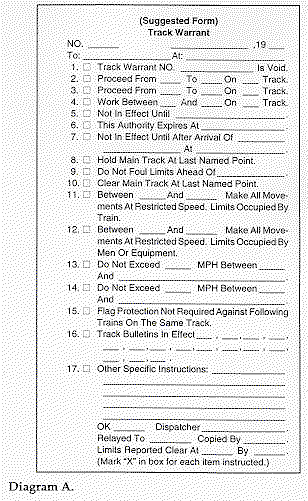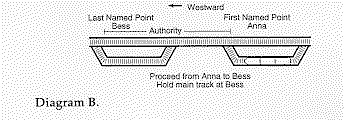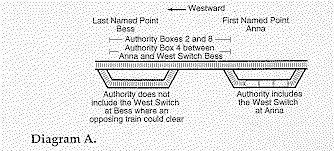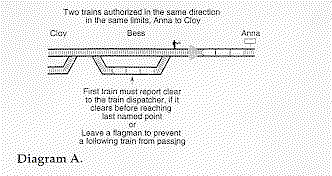

A. First Named Point
When a station name designates the first named point, authority extends from and includes the last siding switch. Authority extends from the station sign if no siding exists.
B. Last Named Point
When a station name designates the last named point, authority extends to and includes the first siding switch. Authority extends to the station sign if no siding exists.
A track warrant must not be issued to protect men or equipment within the same or overlapping limits with a train unless:
A. Transmitting Track Warrants
Time Limit Shown
If the track warrant shows a time limit, the train must clear the limits by the time specified, unless another track warrant is obtained. If the crew members cannot contact the train dispatcher and time limits expire, authority is extended until the train dispatcher can be contacted.
When the limits or instructions of a track warrant must be changed, a new track warrant must be issued showing, "Track Warrant NO.____________ is void" and the number of the track warrant being changed. When a track warrant of a previous date is voided, the date must be included. The previous track warrant will no longer be in effect.
Track warrants that restrict the authority or movement of a train must not be transmitted mechanically, unless the train being restricted will not leave the point without receiving the track warrant.
14.2 Designated Limits
Track warrant limits must be designated by specifying track, where required, and exact points such as switches, mile posts, or identifiable points. However, station names may be used as follows.

14.3 Operating with Track Warrants
A track warrant authorizes a train or engine to occupy the main track within designated limits. However, the train or engine must not foul a switch at either end of the limits where an opposing train may use the same switch to clear the main track.
14.4 Occupying Same Track Warrant Limits
Only one train can occupy the same or overlapping limits of a track warrant except when:
Where track warrant authority includes yard limits or restricted limits, the terms of Rule 6.13 (Yard Limits) or Rule 6.14 (Restricted Limits) apply, but track warrant instructions must be followed.

14.5 Protecting Men or Equipment
Men or equipment may receive a track warrant in the same manner as trains to occupy or perform maintenance on the main track without other protection.
14.6 Movement Against the Current of Traffic
When a track warrant authorizes a train to move against the current of traffic, the train must use only the track designated within the specified limits. This train must not allow a train following on the same track to pass, unless the train dispatcher instructs it to pass.14.7 Reporting Clear of Limits
A train without a crew member on the rear and operating in non-signaled or double track territory may report clear of the limits or report having passed a specific location only when it is known the train is complete. This must be determined by one of the following ways:
In addition, a train clearing in a siding or other track must comply with requirements outlined in Rule 8.3 (Main Track Switches) before reporting clear of the limits.14.8 Track Warrant Requests
An employee who requests a track warrant must inform the train dispatcher what movements will be made and, when necessary, which tracks will be used and how much time is required.14.9 Copying Track Warrants
The conductor and the engineer must have a copy of the track warrant issued to their train, and each crew member must read and understand it. The copy must show the date, location, and name of the employee who copied it. The following must occur when transmitted verbally:
B. In Effect
Employees may relay track warrants.14.10 Track Warrant in Effect
A track warrant is in effect until a crew member reports the train has cleared the limits, or the track warrant is made void. The crew member must inform the train dispatcher when the train has cleared the limits.14.11 Changing Track Warrants
Employees must not add to or alter the track warrant in any manner, except as specified by Rule 15.1.1 (Changing Address of Track Warrants or Track Bulletins).14.12 Voiding Track Warrants
A crew member must write "VOID" across each copy of the track warrant when the train has reported clear of the limits or the track warrant has been made void.14.13 Mechanical Transmission of Track Warrants
Repetition is not required when track warrants are transmitted mechanically. The "OK" time will be given when the track warrant is issued. The space for the name of the copying employee may be left blank.
Next Chapter - Track Bulletin Rules